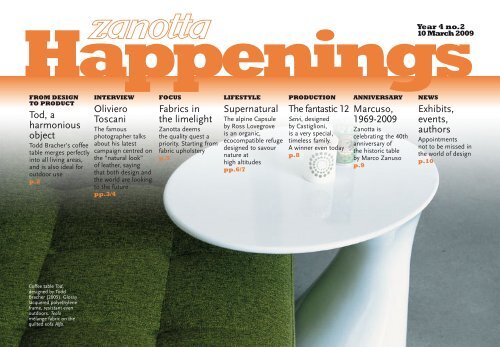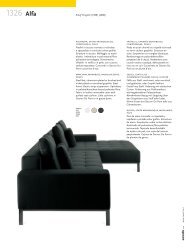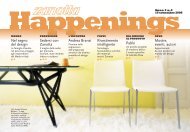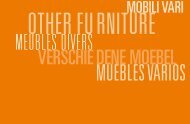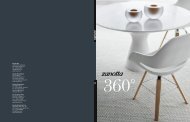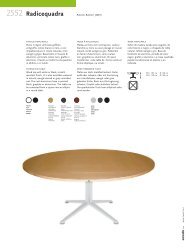Happenings - Zanotta SpA
Happenings - Zanotta SpA
Happenings - Zanotta SpA
- No tags were found...
Create successful ePaper yourself
Turn your PDF publications into a flip-book with our unique Google optimized e-Paper software.
<strong>Happenings</strong>Year 4 no.210 March 2009FROM DESIGNTO PRODUCTTod, aharmoniousobjectTodd Bracher’s coffeetable merges perfectlyinto all living areas,and is also ideal foroutdoor usep.2INTERVIEWOlivieroToscaniThe famousphotographer talksabout his latestcampaign centred onthe “natural look”of leather, sayingthat both design andthe world are lookingto the futurepp.3/4FOCUSFabrics inthe limelight<strong>Zanotta</strong> deemsthe quality quest apriority. Starting fromfabric upholsteryp.5LIFESTYLESupernaturalThe alpine Capsuleby Ross Lovegroveis an organic,ecocompatible refugedesigned to savournature athigh altitudespp.6/7PRODUCTIONThe fantastic 12Servi, designedby Castiglioni,is a very special,timeless family.A winner even todayp.8ANNIVERSARYMarcuso,1969-2009<strong>Zanotta</strong> iscelebrating the 40thanniversary ofthe historic tableby Marco Zanusop.9NEWSExhibits,events,authorsAppointmentsnot to be missed inthe world of designp.10Coffee table Tod,designed by ToddBracher (2005). Glossylacquered polyethyleneframe, resistant evenoutdoors. Teolomélange fabric on thequilted sofa Alfa.
FROM DESIGNTO PRODUCT<strong>Happenings</strong>no.2/09 p.2Find a friend inthe coffee tableTod is a distinctive, versatile andmodern accessory that blendsperfectly into all living areas; it isalso ideal for outdoor useIt may amaze you to hear that I foundinspiration for the coffee table Tod inCindy Crawford! Well, while studyingher portrait I thought she wasundeniably a beautiful woman, but there wasa certain something that made her specialand won her admiration worldwide: her veryspecial beauty spot was a distinctive mark ofcharm. At this point I decided that, as adesigner, I should define that “beauty spot”and turn it into an item that would fit intoany room… ». Hence, Tod’s creation, astrong and yet discrete accessory born of thecreative spirit of Todd Bracher, the youngdesigner from New York. <strong>Zanotta</strong> hasproduced it successfully since 2005. Thiscoffee table has a polyethylene frame andglossy coloured lacquer that perfectly resistseven outdoors. It can be placed near all seattypes in either classical or modern settings.«We must mention - says Bracher - that thespecial lacquering, which was ratherinnovative a few years ago when Tod waslaunched, enhances the coffee table withexceptional refinement, making it a high-endproduct. The wide choice of colours toomakes it a highly “fashionable” item».Produced with the rotational mould method,it is a small jewel of modern industrialdesign. «I created it as an all-round elementthat could sustain both physical and visualspace by easily matching either a sofa or abed. A versatile furnishing item that wouldadd appeal to the spot where it stands.Naturally the coffee table that took shape inmy mind was not meant to play a “key” rolein a certain setting, but the room wouldnever have been the same again without it…Tod’s very shape plays a functional role: itstretches curving upwards to be usefulwithout removing physical or visual space»,says the designer. «The coffee table’sorganic quality visually links the floor and thetable top. The series of harmonious ellipsescontrast with the usual rectangular beds andsofas beside which it is placed. The coffeetable is designed with the awareness that itcould never stand alone, always requiringsomething near it». The object Tod ispractically monomaterial, with over 90 percent of polyethylene and a small steelcomponent in the reinforcement placedunder the base - to stabilise the frame. Thispart can be easily disassembled and, hence,disposed of separately. A small item chargedwith an impressive personality.From left,the designerTodd Bracherand hiscoffee tableTod in asketch and apicture.TODD BRACHERBorn in New York in 1974, hestepped into the international worldof design with items created for<strong>Zanotta</strong> (since 2002). He came to<strong>Zanotta</strong> after attending theDanmarks Designskole for two yearsand the PRATT Institute, New York,for four years, where he graduatedin industrial design in 1996. Heworked as senior designer forvarious architectural firms in NewYork, and for others in Copenhagenand Milan. His works focus onvarious frameworks: from consumerproducts to shop design, furnituredesign and exhibition areas.
<strong>Happenings</strong>no.2/09 p.3CREATIVE POWERINTERVIEW«Conformism is the worstenemy of creativity.Whoever is unwilling totake risks cannot becreative»: Oliviero Toscaniat <strong>Zanotta</strong> <strong>Happenings</strong>,where he enlarges ondesign as one of the drivingforces of Italian quality inthe global marketThe chair Marinadesigned byEnzo Marifor <strong>Zanotta</strong>,interpretedby OlivieroToscani’s lens.Born in Milan in 1942, Toscani isa world famous photographerfor his advertising campaignscharged with social andcommunicational impact (e.g. Benetton,Esprit, Chanel, Fiorucci, Prenatal). Asfashion photographer he has collaboratedand still collaborates with the magazinesElle, Vogue, GQ, Harper’s Bazaar, Esquireand Stern. From 1982 to 2000 he was incharge of Benetton’s advertising. In 1990he formed the magazine Colors andin 1993 Fabrica, the international centrefor art and research in moderncommunications. With Fabrica he haslaunched editorial projects, books, TVshows, exhibitions and shows for the UN,the United Nations High Commission forRefugees, La Repubblica, Arte, Mtv, Rai,Mediaset and movies that have wonawards in Cannes and at the Venice FilmFestival. Toscani’s work is exhibited innumerous museums worldwide. In recentyears he has created a centre for researchin communications, the “ethics factory”La Sterpaia in the San Rossore Park’snatural reserve. Here he launched a newcampaign for the Consortium of GenuineVegetal Tanned Italian Leather, a creativeconcept and a calendar with portraits ofleading entrepreneurs in the Italiantanning industry. “Protagonists” of thehide production number <strong>Zanotta</strong>’s chairMarina “portrayed” for the exhibition thatwill soon visit the USA, in the frameworkof the New York Fashion Week, which willfocus on leather and the best Italianproducts made of this noble material.Q. A binomial created in the Tuscan hillstargets the world: Oliviero Toscani withhis Workshop for the Art ofCommunication and the Consortium topromote the brand “Genuine VegetalTanned Italian Leather.” You havedesigned and published a calendar thatwill promote the work of the most
<strong>Happenings</strong>no.2/09 p.4qualified tanning firms in Pisa, whichproduce skins treated with substancesderived from plants and barks. Can youtell us about this initiative?A. It was very interesting to build theimage of this group of few outstandingfigures in the world. It is unusual andexciting to move with people who standaloof from technology, but who are to dateworld market leaders in terms of quality.Q. For the photos of the “GenuineLeather” campaign you have also chosensome Marina leather chairs by <strong>Zanotta</strong>,designed by Enzo Mari in ’91. What doyou think of the furniture andaccessories <strong>Zanotta</strong> has produced forover half a century?A. <strong>Zanotta</strong> has always been a groundbreakingcompany. It set the trend whenthe world was just realising that designwas an increasingly important factor.<strong>Zanotta</strong> was a precursor of Made in Italyproducts, and this has made it aremarkable, prestigious brand.Q. We know that you appreciate gooddesign items. What are the values youcurrently acknowledge in Italian design?A. Talking about Italian design makes nosense anymore. Design has no passportstoday. It was acceptable in the past, but ifwe wish to look to the future, we mustlearn to artfully exploit globalisation byexpanding and conveying quality instead ofstandardisation, and special featuresinstead of seeking consensus at all costs.Today there are excellent works of Italiandesign created by foreigners and thereverse too. The world is changing andthis is the future.Q. Tuscany is a synonym of culture,tradition, art and handcrafting.A recipe the very best Italian qualityachieves by adding another essentialingredient: innovation. How wouldyou envision a new campaign to backour best production?A. A campaign cannot be devisedoffhand. Many factors should beevaluated, but the foundations forcommunicational actions on the topic aredoubtless present. It takes more couragethan what we currently notice. Oneshould start from the name: Made in Italysounds provincial. We need somethingmore innovative. By now Made in Italycan work for the third world market.Q. The deep international crisis weare experiencing can, from a certainperspective, even give new impetusand a creative shake to minds andproduction processes. What does thiscrisis suggest to you?A. This crisis has finally wiped outmediocrity. Those who have alwaysfaced the market fearfully with aconformist attitude must step aside tomake room for the really skilled. Theseheartless, brainless managers causedthe market slump. The crisis will makeroom for the really deserving, withoutthe hindrance of the incompetent.Master tanners ofthe GenuineLeatherConsortium pose“naturally”,portrayed byOliviero Toscani forthe 2009 calendar.Creative concept byToscani and theSterpaia, Workshopof the Art ofCommunicationsdirected by him.Top, thephotographer.
FOCUS<strong>Happenings</strong>no.2/09 p.5Fabrics inthe limelightManufacturing qualityfurniture has always beenthe focus of <strong>Zanotta</strong>’s workand design philosophy.Starting from the selectionand processing phases offabrics for upholsterySome rolls offabric in<strong>Zanotta</strong>’s NovaMilaneseproduction facility.From the very beginning <strong>Zanotta</strong>decided to control the entireproduction line, ranging from thechoice of materials andcomponents, to finishes, and after-salescustomer service, creating products thatstand out for high design standards,workmanship and functionality. It is no merechance that fabrics play a key role in winningappreciation and success with quality thatcan be personally experienced, and whichhas been confirmed over the years as aguarantee of comfort, duration and safety.These parameters can be scientifically testedby technical regulations applied and updatedby the company throughout its entireindustrial production cycle.Fabric controls: testsconducted by <strong>Zanotta</strong>Colour fastness:mechanical washingwashing with soap at 40°Cdry cleaningdry rubbingartificial lightShrinking and sagging:mechanical washinghand washingdry cleaningPhysical and mechanical resistance:tearingpillingscrapingOVERALL QUALITYFabric upholstery is <strong>Zanotta</strong>’s pride inthe company’s quality quest. Thetechnical, aesthetic and emotionalfeatures of selected collections makeevery product one of a kind, with ampleroom for customisation. Only materialsthat pass the strict resistance andduration controls and tests can step into<strong>Zanotta</strong>’s world. Fabrics are evaluated bya team of experts under the guidance ofEmilio <strong>Zanotta</strong>’s long-standingcompetence. This precise, ongoing taskis carried out only after keen researchconducted in specialist fairs to seek newfibres, yarns and colours presented bythe best producers. The process relieson close cooperation with habitualsuppliers. «Relations established withhistorical suppliers are of the utmostimportance, - says Mr Emilio - Wecooperate with the best textilecompanies in the world, and we knowtheir quality and reliability, just as theyhave learnt to know our philosophy andthe characteristics required of fabricschosen by <strong>Zanotta</strong> for its collections».The company especially works with highendItalian manufacturers, with whom itimplements common research projectsfocused on perfecting targeted productsfor a demanding public.QUALITY TAILORING<strong>Zanotta</strong> beds privilege natural fabrics toattire night with choice fibres obtainedfrom wool, cotton and linen. «Todaynatural fabrics meet the purchaser’sclear appreciation. The ultimatestabilising, anti-crease and anti-stainprocessing methods ensure satisfactionin terms of technical performance»,explains Emilio <strong>Zanotta</strong>. Concerningpadded items, priority is given tocomfortable, resistant fabrics withweaves and shades in tune with modernlifestyles. Fabrics in <strong>Zanotta</strong> collectionsundergo strict controls to ascertain theirexcellence: colour-fastness in artificiallight and to various washing modes andrubbing; shrinking or sagging afterwashing, and physical and mechanicalresistance to numberless conditions ofuse. The label sewn on all fabric coversindicates the composition of the fibre,and provides correct maintenanceinstructions. But a strong point is the“tailor-made” feature. As Mr <strong>Zanotta</strong>says: «The crucial moments of thetailoring phase are cutting and sewing.Concerning the first point, part of it isstill manually performed, and part isentrusted to modern electronicmachinery. Sewing is done with highprecision machines chosen to suit thetype of upholstery that will enhance theproduct with a finish that makes themost of it. Tailoring is an essentialmoment that enhances every elementwith added value. A good fabric, like agood product, would not be suchwithout perfect cutting and sewing».
LIFESTYLE<strong>Happenings</strong>no.2/09 p.6SUPERNATURALRoss Lovegrove’s alpine Capsule is an organic, ecocompatiblerefuge designed to savour nature at high altitudesHumanising abstracttechnologicalforms andcreating beautiful,fascinating and poeticenvironmental design forthe future is a stylistic featuremuch loved by RossLovegrove, the London architectand designer. Hisbook “Supernatu-ral” traceshis inspiring principleswhen he designs items, homesand equipment chargedwith powerful sculpturaland emotional aesthetics.His mission is to exploreinnovative solutions endowedwith quality energyand environmental featuresfor transports, living and lighting.Famous sinuous“eco” creations designed byLovegrove number the seatBrasilia for <strong>Zanotta</strong>, the “solarplants” for Artemide, theSony walk man, BritishAirways’ aircraft seats andOlympus cameras.Lovegrove can turn evenmountains into a symbiosisThe refuge with its “solarplants” for lighting and heating.of organic minimalism andhigh-tech research, as inthis futuristic but concreteproject for a craft, that is virtuallya spacecraft. In fact,he says: «My Cap- sule definesa new sustainable architecturalcondition that isharmonious with nature. Itexpands the potential ofmodern life with its comforts,technological connectionsand visions… the projectis the prototype for anew “off-grid” lifestyle… anew ambition for the 21stcentury that can be adjustedto suit various scenarios.It explores the conceptof dematerialisation, invisibility/visibilityand survivalsystems, which have beenimported from aerospacetechnology and adapted tosuit earthly comfort.» It feelslike living in the world of“Star Trek”, humanised bythe artful use of ergonomicsand materials. The designer-inventor’sidea is toposition a bed under thestars, a round, basic microroomwith walls and ceiling
<strong>Happenings</strong>no.2/09 p.7«The Capsule is asanctuary of peaceand calm, a spot forthinking and imagining,thanks to the everchanging naturallandscape… colours,textures, day and night,and the infinite expanseof the cosmos»Ross LovegroveLovegrove's Capsule can hostcouples of excursionists,who will have to book inadvance. Right: the designer.free of interruptions, in theheart of the Dolomites at analtitude of 2,100 m asl, at thetop of the famous Gran Risaski track (the giant of theworld cup). The enterprisehas been commissioned byMoritz Craffonara, managerof the “Moritzino”, one of themost renown refuges in LaVilla, Alto Adige. «Seen likethis it resembles a drop ofmercury - says Lovegrove -And, in practice, it exploitselectromagnetic fields tohang a few centimetres offthe ground.»BIOMORPHIC REFUGEThe high-tech Capsule has an8 m diameter and comprisesa double acrylic layer coveredby a special mirroring membrane,whose external “skin”reflects the surrounding environmentto dematerialise theobject itself. Guests can revelin the view under all weatherwithout being seen. «Anamazing ethereal space.Stretched in this capsule,even listening to classicalmusic that stimulates thesenses, one can delight in afantastic all-round scenicview of the Dolomites. I cannotimagine a better way ofawakening in the morning,»said Lovegrove. The refuge ofthe future has a central roundedbed, a living area and abathroom. It presents basicwhite surfaces. But the absolutenovelty lies in the factthat the Capsule is entirely independentin terms of energy.It possesses an autonomousgenerator fuelled bythe combination of wind andphotovoltaic power (a set ofminiturbines designed tomake the most of high altitudewinds and petal-shaped,retractable, photovoltaic panels).Scheduled for completionin 2010, this exclusive refugewill be exhibited at thenext Venice Biennale, prior toits installation in the Alps (formore information visitwww.altabadia.org and www.rosslovegrove.com).
PRODUCTION<strong>Happenings</strong>no.2/09 p.8The fantastic 12Servi, a very special, useful,innovative and timeless familydesigned by Castiglioni for<strong>Zanotta</strong>. It is a winner even todayOf all furnishing accessories of modern design,the Servi series by Achille and PierGiacomoCastiglioni is unquestionably the most famous.Developed over a twenty year periodfrom 1961, this collection is to date highly topical. TheMilanese designers envisioned it as a functional, minimal,resistant series; ideal to “serve” both domestic and publicspaces; a sectional, dismountable, modular system.Homogeneous and in progress. A single polypropylenebase, a high or low steel pole that acts as a prop and someaccessories designed to sustain, bear, contain and highlight.Colours: black, white and aluminium. The first tobe designed in 1961 by the Castiglioni brothers’ exceptionalcomposition skills were Servofumo and Servopluvio, respectivelya free-standing ashtray and a basic umbrellastand. The designers made use of just four pieces to buildtwo accessories: a pole, a base, a curved rod and a tub tocollect water that drips from umbrellas in one item and tocollect ash in the other item. They were created - a commonevent among designers who do not find what theyseek in the market - to furnish Milan’s restaurant-pubSplügen. Then came the occasional table Servomuto (designedin 1974, a shelf in black or white stratified plastic laminateor stiff polyurethane with a “prehensile” rod), thefirst to be sent in for production in 1975, followed byServofumo and Servopluvio in 1980, and then by the rest ofthe “family”. When <strong>Zanotta</strong> introduced it the same year atthe Furniture Fair, few understood it immediately, but itsoon won over the market, like the other ten Servi designedby the Castiglionis until 1987. Over the years many of theseitems were added to the permanent collections of sevendesign museums in the world.Servi series, a family of “powerfully” simple occasional tables, coatracks, umbrella stands, coat stands and equipped poles.ON EXHIBITFrom 1984, when Servomostre was added to thecollection, the series designed by Castiglionibecame part of contract furnishings formuseums, and of fittings for fairs, shop windowsand public events. At this point it was a realsystem that met all functional requirements, suchas defining, exhibiting, marking tracks, backingimages and highlighting. From the first historicaldesign and architectural events held in the early’80s to date, there has been a sequence ofdisplays, installations and exhibitions. Servi items,with their typical conical base and supportingpole, have become a classical element to inform,exhibit art and organise multimedia spaces.
<strong>Happenings</strong>no.2/09 p.9ANNIVERSARYMARCUSO1969-2009<strong>Zanotta</strong> is celebratingthe 40th anniversaryof the historic table byMarco ZanusoForty years ago a leading furniturecompany and an internationallyfamous designer joined forces tocreate an “icon” piece of industrialdesign. The Marcuso table was createdin 1969 as a result of the ideal combinationof research and innovation. It markedthe first use of a ground-breaking methodtypical of the automobile industry forthe creation of a table: specifically, crystalglass and stainless steel were fastened together.The idea struck Aurelio <strong>Zanotta</strong>while he was observing the butterfly windowsof cars, which are simple latchesglued to crystal glass. He decided to applythe system to his production by entrustingthe task to the most technologically-mindedarchitect-designer in those years:Marco Zanuso. Zanuso found a solution tofasten the steel legs to the crystal tabletop.He simply glued four stainless-steeldiscs directly on it (using an unprecedentedtechnique for those years in which gluewas polymerised using ultraviolet rays).The Marcusotable in a periodphoto from<strong>Zanotta</strong>’sarchive.The discs were threaded so the legs couldbe screwed on later. The procedure simplifiedboth production and packaging. TheMarcuso table is one of the best examples ofindustrial design that merges research andpassion shared by the manufacturer, designerand technical office. Hence, in 2005the famous design critic Pilar Viladas wrotein the New York Times Style Magazine thatMarcuso was the item he preferred of thosedesigned by Zanuso, and that it impressedhim for the innovative top and leg fasteningsystem. «This detail caused me to study itleisurely when I first saw the table at a designshow. It was then I understood the relationshipbetween technology and aestheticsin modern industrial design... It has somethingto do with that special “verve” ofmodern style, which, all considered, is oneof Italy’s greatest contributions to the worldof design». Marcuso is still in production.Versions include a square, rectangular andround table-top, each in different sizes andwith stainless-steel, black or graphite legs.
NEWSNot to missExhibits, events, authors<strong>Happenings</strong>no.2/09 p.10WEARABLEARCHITECTUREAn innovator in terms ofmaterials, fastidiousconcerning the cut, andfascinated by the ultimateproduction technologies.It is no mere chance thatHussein Chalayan wastwice acclaimed “BritishDesigner of the Year”.The London exhibition is acomplete review of worksby the forty-year old TurkishCypriot designer. It spansfifteen years in thebusiness, from his debutto the success met bycollections designed forTSE (USA) and Yoox.Chalayan keeps inventing,testing and challenging.The exhibition directs thespotlights on objects turnedinto clothes: the “wearable,portable architecture” thatmade him world famous,with LEDs on fabric,Swarovski crystal dresses,and moving laser beams forspectacular light effects.A new conception of luxury.At the Design Museumuntil 17th May.THE GENIUS IS BACKThe review organised topromote Italian creativityis back “home” after ahighly successful worldtour: Italian Genius Now.It has naturally mergedinto Macro Futureexhibition areas in Rome -the institution that hasbecome a powerfulattraction in barely a fewyears - where visitors canfollow a personal track, anintellectual, sensoryjourney amidst industrialobjects, images andproducts representing thespirit and commitment ofItalian design-orientedculture. From the VespaGS 150 by CorradinoD’Ascanio to aerospaceexperimentation by PaoloScheggi, from moderndesign by AchilleCastiglioni (with itemsdesigned for <strong>Zanotta</strong>) tothe works of MimmoPaladino. An absolutemust, open until 13 April.ZANOTTA AT THE 2009FURNITURE FAIROn 22 - 27 April 2009Milan will host the yearlyleading international fair offurnishings and design:the International Fair ofFurniture and FurnishingAccessories, with Euroluceand the Satellite Fair.<strong>Zanotta</strong> will be in the RhoFair design pavilions with alarge stand displaying itsultimate productsdesigned by some of themost intriguingcontemporary designers.Many will also be thereference projects in theheart of Milanese culture:in Palazzo Reale animportant anthologicalexhibition will compareperiod and modernfurnishings, numberingsome of <strong>Zanotta</strong>’shistorical pieces, like theCumano coffe table(spotlighted in theexhibition poster). The<strong>Zanotta</strong> Shop in Milan willorganise an event withFabrica’s creative team forOperation FZ part two.HSIAO’S JOURNEYThe bridge is the ideogramthat most appropriatelyrepresents Hsiao Chin, thefamous Chinese painter.For over 50 years HsiaoChin - born in Shangai in1935 - focused on linkingEast and West in his lifeand paintings. Theexhibition fitted out at theBovisa Triennale, with<strong>Zanotta</strong> as technicalsponsor, is the bestevidence of this trend.“Hsiao Chin. In-FiniteJourney 1955-2008” is aselection of over 100paintings that reveal theartistic track followed by themaestro from Shanghai(who lived long in Europeand in the USA). He settleddown in Milan at the age oftwenty, then travelled theworld and returned to Italyto focus on painting andteaching. In 2006 Beijingorganised a personalexhibition for him at theNational Art Museum.Bovisa Triennale, Milan,until 5 April.ALL ABOUT SOTTSASSThe architect anddesigner Ettore Sottsasswas a highly talentedsculptor, painter, authorand photographer. Theundisputed promoter ofideas and energies thatfed passions and achievedindustrial success. Thefarsighted MuséeNational d’Art Moderne inParis purchased his workssince the ’90s, thusbuilding a preciousheritage of 420 items thatare now presented in anexhibition - homage to afree spirit. “Hommage àEttore Sottsass” displaysceramics, jewels,consumption products,ideas and projects,posters, furnituredrawings, and lithographsthat show how Sottsass’creations respectergonomics andindustrialisation,invention and individualimagination. At CentrePompidou in Paris,until 31 March.ROOTSSon of one of the lastweavers of Lyon,Dominique Mathieu -young designer who hasdesigned for <strong>Zanotta</strong> since2002 - proves with hisexhibition held at theCentre d’art contemporainde Brétigny that a youngtalent can pay homage tocultures and trades thatcame before it. “Rewriting”the forms of weavers’ workspace, Mathieu deeplyenthrals the spectator byperfecting new flexibleprojects and revisitingfamiliar objects, fabricsand colours. At theC.A.C. in Brétigny s/Orge,until 21 March.Editorial project Giuliana ZoppisGraphic design Stefania GiarlottaCoordination and supervision <strong>Zanotta</strong> spaCopyright <strong>Zanotta</strong> spaThe use of texts and images are subjectto <strong>Zanotta</strong> authorizationPress office <strong>Zanotta</strong>tel. 0362.4981www.zanotta.itcommunication@zanotta.it


